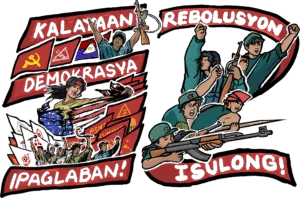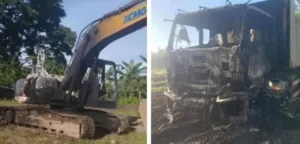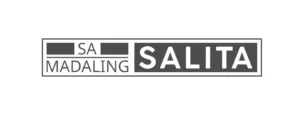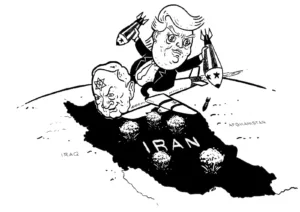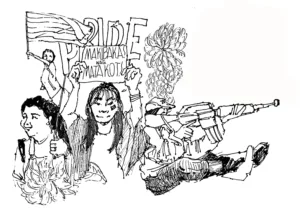By LUIS G. JALANDONI
NDFP Chief International Representative
Member‚ NDFP National Executive Committee
This growth and achievements over the past 35 years are possible only with the support of the masses. We honor the many martyrs and heroes among the masses and the NDFP leaders who gave up their lives for the Filipino people and the Philippine revolution. We also honor our internationalist friends who have rendered and are still rendering selfless service to the Filipino people.
On the firm foundation of the 35 years of glorious revolutionary struggle, we are confident of winning more victories in the years to come until we achieve nationwide victory in our struggle for national and social liberation. By LUIS G. JALANDONI
NDFP Chief International Representative
Member‚ NDFP National Executive Committee
The National Democratic Front of the Philippines (NDFP) was conceived in the midst of the rapid growth of the revolutionary mass movement in 1971. This was soon after the repeated militant mass actions in early 1970, called the “First Quarter Storm”. The ferment of resistance against the Marcos regime was rising to boiling point. It was then that the Communist Party of the Philippines formed the Preparatory Committee (PrepCom) of the National Democratic Front of the Philippines.
Months after Marcos declared martial law in September 1972, a mass campaign “NO TO MARTIAL LAW” arose. The NDFP PrepCom announced its 10-Point Program on 24 April 1973. This has been celebrated as the founding of the NDFP.
The roots of the Filipino people’s national democratic struggle go back to the armed revolution for independence against Spain in 1896 and their struggle against US aggression in 1899-1913. These struggles were preceded by more than 200 revolts against Spanish colonial rule. All these became an accumulated powerful revolutionary tradition.
The Kabataang Makabayan (KM – Patriotic Youth), the Christians for National Liberation (CNL), MAKIBAKA revolutionary women’s organization and other legal democratic organizations went underground upon the declaration of martial law. Within the framework of the NDFP, they allied themselves with the Communist Party of the Philippines and the New People’s Army, which had worked clandestinely since their founding in December 1968 and March 1969 respectively.
The revolutionary peasant movement, set up and nurtured by the CPP and the NPA, became a wide network to provide safe haven and assistance to the urban members of the NDFP. At the same time, the urban cadres of the NDFP helped the leadership of the revolutionary movement in its vital initial needs by providing safe places, communications and transport, and other political and material support.
In 1975, after several changes in leadership due to arrests, NDFP PrepCom head Edgar Jopson, a former student leader, streamlined the NDFP organization. The NDFP PrepCom initiated in 1976 its GZ-Prep (Guerrilla Zone Preparation) program. This meant that legal activists, often progressive Church people, would undertake legal organizing of peasants and later turn this over to revolutionary forces to develop guerrilla zones. This helped in the expansion of the guerrilla fronts to 29 by the end of the 1980.
In November 1977, the NDFP elaborated its 10-Point Program. This became the 12-Point Program with separate articles on the women’s movement and the Moro and other national minorities.
The major part of the work of the NDFP allied organizations is in the wide countryside. Mass organizations of peasants and farm workers, workers, women, youth, cultural groups and children are set up. Mass campaigns for land reform, health, education, culture, and self-defense are carried out in response to the peasants’ basic needs. Organs of political power or alternative governments on the barrio level are formed, while the New People’s Army and the CPP are strengthened.
In 1980, the Permanent Peoples’ Tribunal (PPT) declared the NDFP the legitimate representative of the Filipino people and recognized the status of belligerency of their revolutionary armed struggle. The PPT declared the dictator Marcos unfit to govern and condemned his regime for its grave crimes against the people.
In 1992, the CPP launched the Second Great Rectification Movement to correct major errors instigated and carried out by a small group that turned out to be renegades in the leadership of the CPP. All the other allied organizations of the NDFP joined the CPP and the masses in carrying out this mainly educational movement to identify, repudiate and correct the errors. The overwhelming majority of cadres and members of the revolutionary movement and the masses embraced the rectification movement as the small group of renegades refused to accept their responsibility and turned against the revolutionary movement and the people.
The Second Great Rectification Movement laid the foundation for vigorous growth, consolidation and expansion, including recovery of lost areas and communities. Since then, the NDFP allied organizations s have widened and deepened their work among the masses in the countryside and urban areas.
Some concrete examples of the revolutionary work on the ground are:
On land reform, the NDFP program declares: Implement a genuine agrarian reform program, promote agricultural cooperation, develop rural production and employment through modernization of agriculture and rural industrialization, and ensure agricultural sustainability.
In Mindanao, southern Philippines, the revolutionary forces conducted the “balik-bukid” or “return to farm” campaign in 2006. A multinational firm claiming 400,000 hectares of land was using the military, police and private security guards to forbid peasants from tilling the land. But the peasants, supported by the New People’s Army, persevered in the campaign until more and more of the peasants could settle in the areas which cannot be continuously guarded by the company’s armed goons. Principal crops planted are rice, corn and vegetables. The balik-bukid campaign also includes the formation of peasant associations and cooperatives, mutual exchange of labor and communal production.
In Cagayan Valley in northern Philippines, also in 2006, more than 71,000 peasants in 52 villages from eight towns benefited from the agrarian struggles despite intensive military operations and harassment. The peasants were able to reduce interest rates on their loans from 7% per month to 2.5 %. In other areas, land rent was reduced to one-fourth of net production from a previous one-third of gross production. In other villages, tenant farmers have completely stopped paying land rent.
In the Bicol region, in southern Luzon, the revolutionary movement was able to reduce land rent in over 35,000 hectares of land, benefiting over 10,000 families.
The NDFP health program calls for emphasis on preventive services, giving special attention to primary health care and strengthening full participation in people-based programs. It also calls for effective and appropriate medical technology and the use of both traditional and modern medicine. A concrete example is the anti-malaria campaign conducted in Cagayan Valley. It should be noted that malaria affects an estimated 10 million people in 65 out of a total of 81 provinces.
The regional NPA command conducted a training on malaria among 24 NPA medics and 25 villagefolk. The training program included the early detection and diagnosis of the the signs and symptoms of malaria, distinguishing malaria from other diseases with similar symptoms, a new treatment regimen and disease prevention. Graduates of the training led the formation of village-level health committees. Committee members were also given training in acupuncture.
In one of the barrios, the NPA medics gave acupuncture treatment to an old woman who was paralyzed for five years. Committee members continued the treatment when the NPA medics left. After three weeks, the medics received a letter, “Grandmother can now walk, when will you be back?”
During a three-month period, 2,000 people were provided health services and 10 community clinics were set up. Nine villagers joined the NPA.
A major campaign of the NPA and other revolutionary forces in the rural areas is literacy and numeracy. In some areas, revolutionary elementary schools have been set up. This is part of the NDFP national program for continuing nonformal, special and adult education on literacy and numeracy and appropriate skills training for production.
Cultural programs also form an important activity of the revolutionary forces. Through performances, songs and poetry, the situation and struggles of the masses are depicted. Thus, from the beginning, cultural programs have played an important role in raising the political consciousness and enthusiasm of the masses.
Self-defense units are formed and given training. They assist the NPA in protecting the communities and carrying out tactical offensives.
In the urban areas, NDFP allied organizations promote the workers’ struggles, the revolutionary mass movement, the struggle for human rights, and political work within reactionary institutions. They join the masses in the campaign to oust the corrupt, illegal and fascist Arroyo regime. They help build alliances to broaden the national united front in support of the overall revolutionary struggle.
Abroad, the NDFP allied organizations promote the work among overseas Filipinos to defend and uphold their rights and foster their participation in and support for the Filipino people’s liberation struggle. It also develops international solidarity with peoples from different countries, fostering mutually beneficial cooperation in the struggle against imperialist globalization and wars of aggression.
The NDFP likewise carries out proto-diplomatic and diplomatic work to win support and recognition from governmental and intergovernmental institutions abroad. The NDFP Negotiating Panel and its consultants, staff and volunteers are also tasked with undertaking peace negotiations with the reactionary government.
This growth and achievements over the past 35 years are possible only with the support of the masses. We honor the many martyrs and heroes among the masses and the NDFP leaders who gave up their lives for the Filipino people and the Philippine revolution. We also honor our internationalist friends who have rendered and are still rendering selfless service to the Filipino people.
On the firm foundation of the 35 years of glorious revolutionary struggle, we are confident of winning more victories in the years to come until we achieve nationwide victory in our struggle for national and social liberation.
